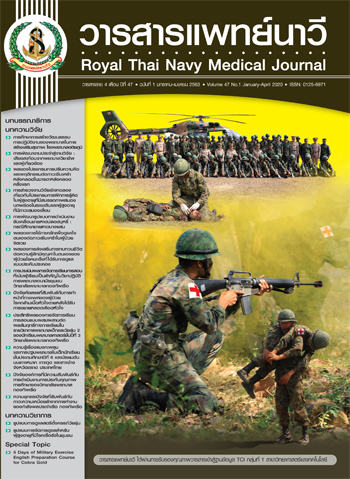Development of Smoking Free Beach Implementation Model : Case Study of Bangsaen Beach
Main Article Content
Abstract
This participatory action research aimed to develop a smoking free implementation model in Bangsaen beach. The study was divided into 3 phases as follows; Situational analysis and participatory planning, model development, and effectiveness evaluation by lesson learned from the committee and the perception of the people. 180 participants included were smoking free beach committees, working groups, entrepreneurs and local population in Bangsaen beach. Data were obtained by interviewing, focus group discussion, questionnaires and workshop between May-December 2019. Quantitative data were enumerated by frequency and percentage, and qualitative data were analyzed by content analysis.
A content analysis showed that components of a smoking free implementing model in Bangsaen beach consists of 1) launching the smoking free beach policy, 2) improving a competency among smoking free beach committees, and 3) participatory implementation plan by a stakeholder network including stakeholder network capacity building, public relations campaign, and continuity of implementation plan focusing on the systematic of planning, implementation, and effectiveness of evaluation. The effectiveness of evaluation showed that the participants were satisfied with the model and activities because it causes a continuous decreasing of smoking on the beach and causes an increasing of smoking free among general public.Continuous implementation plan and stakeholder network capacity to launch a legal measure are the key success factors of a smoking free implementation model. Therefore, the implementation model should focus on the integration among stakeholder network with the local administrative organizations to act as the focal point by enhancing the potential for health communication of the working groups and entrepreneurs that are the important group for driving activities. The next study should focus on research to develop the reporting and communicating innovations about the smoking free beach for tourists leading to a healthy community.
Article Details

This work is licensed under a Creative Commons Attribution-NonCommercial-NoDerivatives 4.0 International License.
References
2. Non-Smoker’s Health Protection Act B.E. 2535 (A.D. 1992). Royal Thai Government Gazette. Vol. 109 part 40 (1992, 7 April). (in Thai).
3. Marine and Coastal Resources Management Promotion Act B.E. 2558 (A.D. 2015). Royal Thai Government Gazette. Vol. 132 part 21A (2015, 26 March). (in Thai).
4. Tovisetkul CP. Guidelines for law enforcement on the health protection of non-smokers in the eastern tourism beach of Thailand. Journal of Politics, Administration and Law 2011;3(2):211-40. (in Thai).
5. The Command of the Department of Marine and Coastal Resources 1064/2560 the protection measure of marine resources and coastal beaches. Royal Thai Government Gazette. Vol. 134 special part 269D (2019, 2 November). (in Thai).
6. Kungskulniti N, Charoenca N, Mock J, Hamann SL. Secondhand smoke point-source exposures assessed by particulate matter at two popular public beaches in Thailand. Journal of Public Health 2017;40(3):527-32.
7. Phetphoom C, Pyeamkleep R, Pongpreecha B. Factors affecting avoidance behavior of secondhand smoke among students in the University. The Public Health Journal of Burapha University 2018;13(2):89-101. (in Thai).
8. World Health Organization. Toolkit for delivering the 5A’s and 5R’s brief tobacco interventions in primary care. Geneva: WHO Press; 2014.
9. Department of Marine and Coastal Resource, Ministry of Natural Resources and Environment. ‘NGOs’ found marine debris worldwide, 166 million of ‘smoking’ championship. [Internet]. [cited 2019 November 12]. Available from: https://www.dmcr.go.th/detailAll/ 2875/nws/16. (in Thai).
10. The Committee of Non-Smoking Beach, Saensuk municipality. Resolution of the non-smoking beach on 9 November 2017. Copied document. (in Thai).
11. Preechawong S, Charoenca N. What is the WHO framework convention on tobacco control. Bangkok: Charoendee Munkong Printing; 2010. (in Thai).
12. Vathesatogkit P. 1 decade of WHO framework convention on tobacco control. [Internet]. [cited 2019 November 12]. Available from: https://www.hfocus.org/content/2015/03/9430. (in Thai).
13. Bureau of Tobacco Consumption Control, Department of Disease Control, Ministry of Public Health. Second National Strategic Plan for Tobacco Control 2016-2019. Nonthaburi: Nice Earth Design; 2016. (in Thai).
14. World Health Organization. World no tobacco day 2007. [Internet]. [cited 2007 May 29]. Available from: https:// www.who.int/tobacco/communications/events/wntd/ 2007/en.
15. Ampansirirat A, Wongchaiya P. The participatory action research: key features and application in community. Journal of Humanities and Social Sciences Mahasarakham University 2560;36(6):192-202. (in Thai).
16. Jeawkok J, Yammai S. Participatory action research for community development. Hatyai Academic Journal 2559;14(1):79-95. (in Thai).
17. Crane P, O' Regan M. On PAR: Using participatory action research to improve early intervention. Department of Families, Housing, Community Services and Indigenous Affairs. Australian Government: Canberra; 2010.
18. Holsti OR. Content analysis for the social sciences and humanities. Reading, MA: Addison-Wesley Publishing Company; 1969.
19. The Committee of Non-Smoking beach, Saensuk municipality. Resolution of the non-smoking beach on 4 September 2019. Copied document. (in Thai).
20. Griffiths J, Magge H, George E. Stakeholder involvement: background paper prepared for the WHO/WEF Joint event on preventing non-communicable diseases in the workplace. World Health Organization: Geneva; 2008.
21. Chanyapornpong M, Khunpluem N, Wongsuthilert A, Jaidee W, Jaidee PH. Knowledge and compliance of tourist according to the law on smoking-free area: case study of Bangsaen beach. Journal of Public Health Naresuan University 2562;1(1):25-38. (in Thai).
22. Moorhead SA, Hazlett DE, Harrison L, Carroll JK, Irwin A, Hoving C. A new dimension of health care: systematic review of the uses, benefits, and limitations of social media for health communication. Journal of Medical Internet Research 2013;15(4): doi:10.2196/jmir.1933.
23. Baker EL, Alkin MC. Formative evaluation of instructional development. Educational Technology Research and Development 1973;21(4):389-418.
24. Coughlin SS, Anderson J, Smith SA. Legislative smoking bans for reducing exposure to secondhand smoke and smoking prevalence: opportunities for Georgians. Journal of the Georgia Public Health Association 2015;5(1):2-7.


